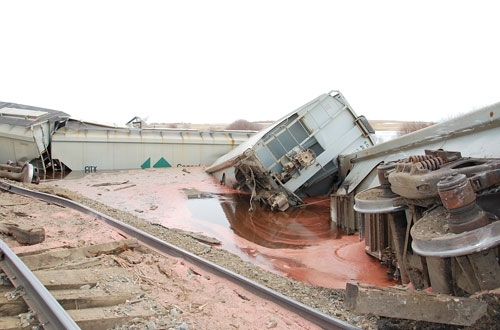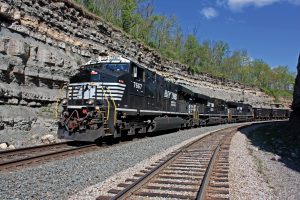Canada’s TSB attributes CP derailment to poor drainage
Written by Mischa Wanek-Libman, editor
The Transportation Safety Board of Canada (TSB) published its report on an April 2013 Canadian Pacific accident and found poor drainage and water-damaged track bed led to 17 cars derailing.
TSB said limited capacity of the drainage system beside the tracks led to the saturation of the track bed and created a void under the tracks. As the heavily loaded train crossed that section of the tracks, the weakened track structure failed resulting in a derailment.
Approximately 350 feet of track was destroyed in the April 28, 2013, derailment that occurred at Mile 80.7 on the Hardisty Subdivision, near Provost, Alberta.
The report said, “There had been no reported drainage problems in the area of the derailment. Local observations were that the area was generally dry. A culvert was in place at Mile 80.5, about 1,000 feet east of the point of derailment (POD), to facilitate drainage water to flow south to north. Excess water would normally flow from the west and pass through the culvert, but ice in the south ditch restricted flow to the culvert allowing water to back up in the ditch.”
The report found:
- The derailment occurred when the train passed over a track irregularity due to a track subgrade failure.
- Due to the limited capacity of the drainage system, the water level was higher on the south side of the track relative to the north side, resulting in above normal water infiltration and saturation of the track subgrade.
- The water flow through the track subgrade created a void below track level as ballast and subgrade material were lost from between and beneath the ties, reducing the capacity of the track to support the passing train.
- The vertical force of the heavily loaded unit train on the poorly supported cribbed tie gap resulted in failure of the track structure.
The report said, “At CP, much of the training program relating to geotechnical hazards and the spring preparedness plans were specifically designed to prevent derailments attributable to roadbed failure during the spring thaw period. The detection of a weak track subgrade is an important component of the track inspection regimen. In this occurrence, the presence of elevated water levels on one side of the track was an indicator of poor track drainage and the possibility of track weakness in the area of the derailment. If geotechnical hazards are not specifically identified and addressed, track structure degradation may occur, increasing the risk of derailments.”
The entire report is available through the TSB’s website.





